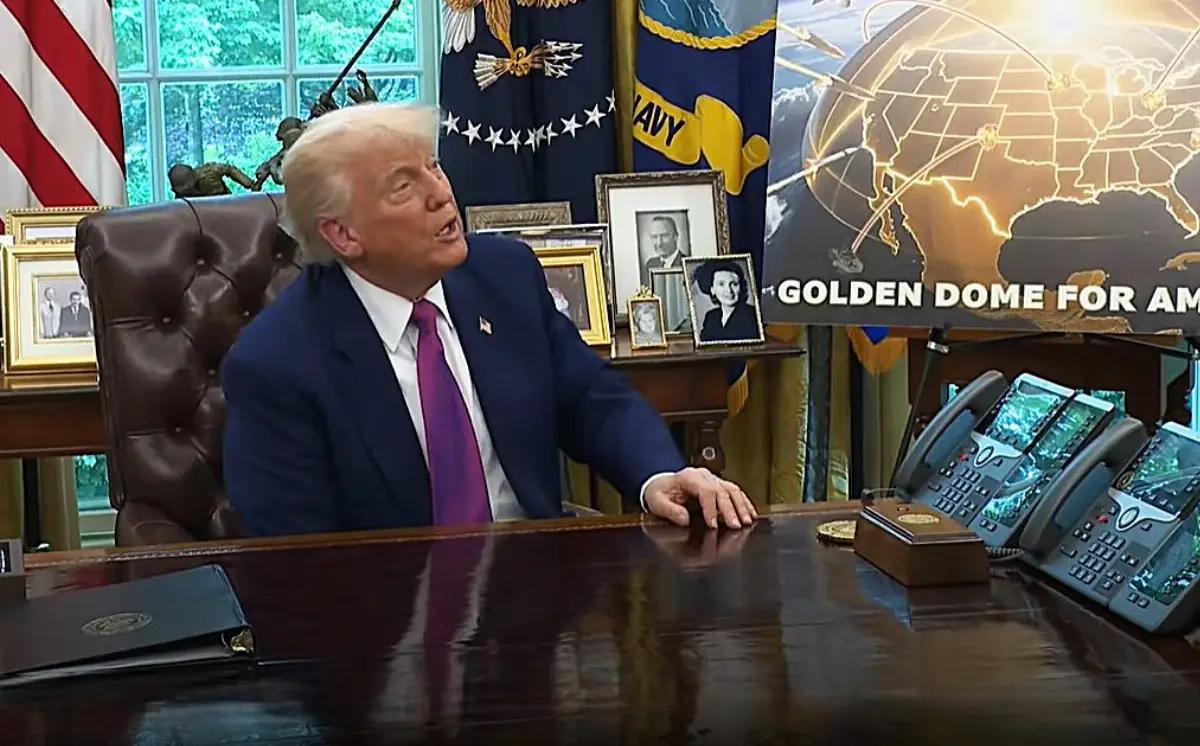
Trump unveils the "Golden Dome," American space missile defense plan
The return of the "Star Wars": how Trump plans to protect the US from space /VIDEO

The White House has released a video in these hours that has captured global attention, in which President Donald Trump emphatically announces the ambitious national defense project "Golden Dome". The plan, presented as a definitive response to emerging missile threats, promises to revolutionize the security of the United States through an unprecedented space defense architecture. The footage, which quickly went viral worldwide, shows Trump illustrating the vision of an unparalleled "umbrella" shield designed to intercept and neutralize any type of missile, wherever it is launched from, even from deep space.
The core of the "Golden Dome" is a multi-layered, high-tech missile defense system, conceptually inspired by the success of the Israeli Iron Dome but projected on a global and space scale. The plan foresees the deployment of a complex and extensive network of hundreds of advanced satellites, ultra-sensitive sensors, and kinetic and directional interceptors. These components will work synergistically to precisely detect missile threats during launch or in flight, track their trajectory, and neutralize them before they can reach American territory or its allies. Some interceptors are expected to be positioned in space, offering a reaction capability and coverage previously unimaginable.
Regarding costs, the president initially projected an expenditure of approximately 25 billion dollars as part of a dedicated government funding plan. However, defense sector analysts and experts estimate that the total cost for the implementation and maintenance of a system of this magnitude could balloon to as much as 500 billion dollars over several years. This figure underscores the immense financial commitment required from the current administration. The timeline announced by Trump was equally bold. The president declared that the "Golden Dome" should be fully operational and capable of providing complete protection by the end of his current term. Although ambitious, this schedule highlights the sense of urgency and determination to complete the project within a relatively short timeframe, considering the technological and engineering complexity. The development of the project will be supervised by Space Force General Michael Guetlein, emphasizing the central role of the new US military branch.
Elon Musk: a potential partner, but with reservations
The ambition of the "Golden Dome," which involves hundreds of satellites, immediately directed attention towards Elon Musk and his companies. SpaceX, with its launch capabilities and the Starlink network, would be ideally positioned to undertake such a space project. Despite speculation and reports about possible proposals for the creation of a satellite surveillance network, Musk has denied (as he already did last April) any active involvement of SpaceX in the project. However, he left the door open, stating that if explicitly requested by the president, the company would consider offering its assistance.
A dream that returns: Reagan’s legacy and the "Star Wars"
The announcement of the "Golden Dome" has not gone unnoticed not only for its technological ambition but also for its deep historical echoes. The concept of a "space shield" to protect the United States from missile attacks indeed harks back to a much older dream, that of former President Ronald Reagan and his Strategic Defense Initiative (SDI), popularly known as "Star Wars". Launched in 1983, Reagan’s SDI was a research and development program aimed at creating a missile defense system based on space weapons, capable of intercepting intercontinental ballistic missiles. Although the SDI was never fully realized in its original form, remaining mostly a research project, it represented a turning point in American strategic thinking, shifting the focus from deterrence based on "mutually assured destruction" to active defense against missile attacks.
Today, with the "Golden Dome," Trump seems to fully embrace that "dream" of Reagan, adapting it to the technologies and threats of the 21st century. Both projects share a vision of technological superiority to ensure national security, but the "Golden Dome" benefits from exponential advances in fields such as artificial intelligence, microsatellites, sensors, and space propulsion, making the technical realization of such a shield more plausible (albeit not simple). This ideological continuity between the two administrations underscores how the pursuit of absolute defense against missile threats remains a constant in American security policy, with the "Golden Dome" positioning itself as the latest and perhaps most ambitious incarnation of this aspiration.
The announcement has already generated reactions at the international level, with China expressing serious concerns about the potential militarization of space and the risk of a new arms race, while Russia has underlined the importance of prior dialogue on the project.
For more on missile defense, see also AVIONEWS.
Below, the president’s announcement:
AVIONEWS - World Aeronautical Press Agency